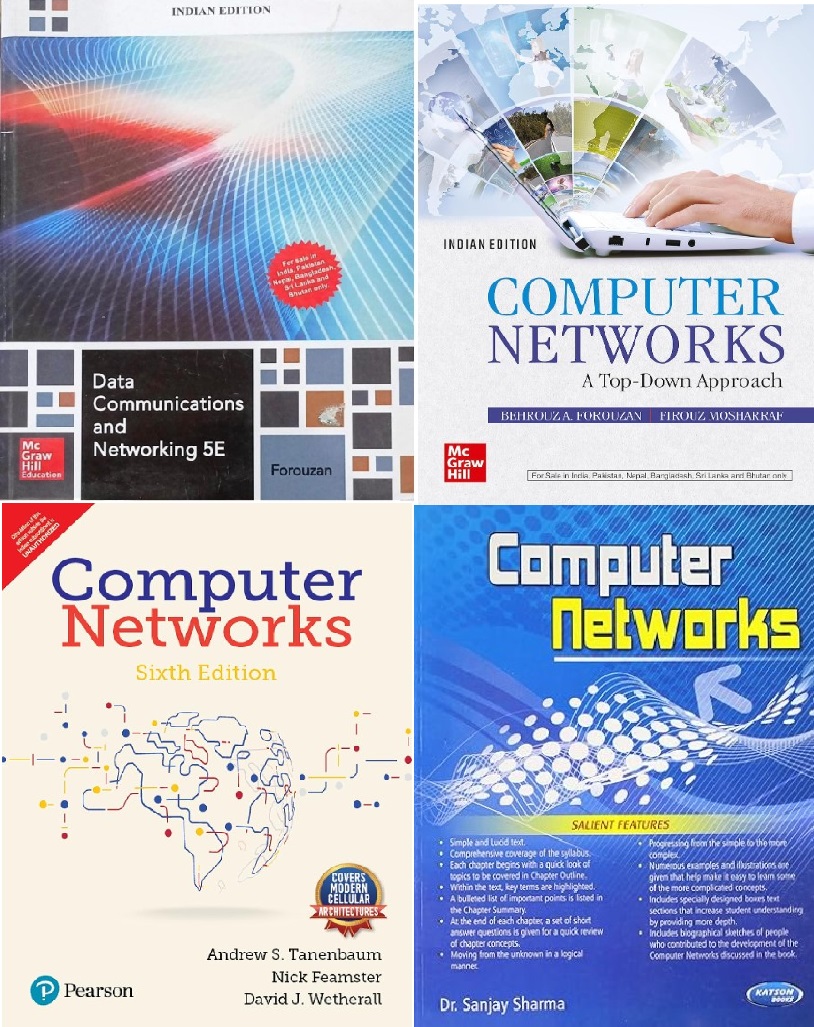Unit 1
Introduction to Data Communication Definition: Effectiveness, Basic Communication Components. Network Architecture Definition, History, Criteria, Goals and Applications of Networks, Categories of networks, Organization of the Internet, ISP, Protocols and standards, The OSI reference model, TCP/IP protocol suite, Network devices and components. Network topology design, Types of connections.
Q81 – Presentation Layer is concerned with …………….
Synchronization
Flow Control
Syntax and Semantics
File Transfer
Ans – (3)
Explanation – The Presentation Layer of the OSI model is primarily concerned with syntax and semantics. This layer ensures that data exchanged between systems is in a format that the receiving system can understand. It handles tasks such as data encryption, compression, and conversion between different data formats.
Q82 – Which layers of the OSI model are host-to-host layers?
Transport, Session, Presentation, Application
Network, Transport, Session, Presentation
Datalink, Network, Transport, Session
Physical, Datalink, Network, Transport
Ans – (1)
Explanation –
The host-to-host layers of the OSI model are the layers that facilitate communication between devices on a network, typically from the Network layer up to the Application layer.
These layers handle data transfer, session management, and application-specific functions. However, if we focus on the essential host-to-host communication layers, they are generally considered to be from the Transport layer upwards. Transport, Session, Presentation, Application.
Q83 – What are the advantages of 7 layers of OSI model?
Troubleshooting the network is easy.
Developing new functions or services for a particular layer is easy.
Developing hardware devices targeting certain layers is easy because the services to be offered are fixed.
All of the above
Ans – (4)
Explanation –
The layered approach of the OSI model helps in troubleshooting network issues as problems can be isolated to specific layers, making it easier to identify and resolve issues without affecting other layers.
The modular design of the OSI model allows for the development of new functions or services for a specific layer without affecting the other layers. Each layer operates independently, enabling flexibility in implementing new technologies or protocols.
The well-defined services provided by each layer in the OSI model make it easier to develop hardware devices targeting specific layers. Since the functions and responsibilities of each layer are fixed, hardware developers can design devices to meet the requirements of a particular layer without needing to consider the entire network stack.
Q84 – The transmission media like ___ are part of the Physical layer of OSI model.
Copper cables
OFC – Optical Fiber Cables
RF – Radio Frequency waves including Microwaves
All of the above
Ans – (4)
Explanation –
The Physical layer of the OSI model is concerned with the transmission of raw data bits over a physical medium. This includes various types of transmission media, such as copper cables, optical fiber cables, and radio frequency waves including microwaves. All of these transmission media are part of the Physical layer as they provide the means for transmitting data signals between devices.
Q85 – Suppose your network is connected to another network via a router. Which OSI model layer provides the information necessary to direct data between the two
networks?
Network layer
Physical layer
Data Link layer
Session layer
Ans – (1)
Explanation –
The Network layer is responsible for routing and forwarding data packets between different networks by providing logical addressing, such as IP addresses. Routers operate at this layer and use the information in the Network layer headers (such as IP addresses) to determine the best path for data transmission between networks.
Q86 – Two sides cannot attempt the same operation at the same time. This property is accomplished by ……………….
Session Layer
Transport Layer
Physical Layer
Network Layer
Ans – (1)
Explanation –
The token management function of the session layer is in charge of preventing two users from accessing or performing the same critical operation at the same time.
Q87 – When data are transmitted from device A to device B, the header from A’s layer 4
is read by B’s _______ layer.
Physical
Transport
Application
None of the above
Ans – (2)
Explanation –
When data is transmitted from device A to device B, the header from A’s Layer 4 (Transport layer) is read by B’s Transport layer.
The Transport layer (layer 4) is responsible for end-to-end communication between devices and ensures that data is reliably delivered. It uses headers added by the sending device’s Transport layer to determine how to handle the data upon arrival.
Q88 – The TCP/IP _______ layer is equivalent to the combined session, presentation, and application layers of the OSI model.
Application
Network
Data link
Physical
Ans – (1)
Explanation –
The TCP/IP layer that is equivalent to the combined session, presentation, and application layers of the OSI model is the application layer.
Q89 – TCP/IP is a ______ hierarchical protocol suite developed ____ the OSI model.
seven-layer; before
five-layer; before
six-layer; before
five-layer; after
Ans – (2)
Explanation – TCP/IP is a five-layer hierarchical protocol suite developed before the OSI model.
The TCP/IP model was created in the 1970s as part of the development of the ARPANET, the precursor to today’s internet. It was designed to be a simple and flexible protocol suite for connecting different types of computer networks.
The OSI model, on the other hand, was developed later, in the late 1970s and early 1980s, by the International Organization for Standardization (ISO).
Q90 – The _________ layer enables the users to access the network.
Transport
Application
Data link
Physical
Ans – (2)
Explanation – The layer that enables users to access the network is the application layer.
The application layer provides network services directly to end-users or application processes. It allows users to access network resources and services such as web browsing, email, file transfer, and remote access.
Q91 – The _______ layer ensures interoperability between communicating devices through transformation of data into a mutually agreed upon format.
Transport
Network
Data link
Presentation
Ans – (4)
Explanation – The layer that ensures interoperability between communicating devices through the transformation of data into a mutually agreed-upon format is the presentation layer.
The presentation layer is responsible for translating data from the format used by the application layer into a format that can be transmitted over the network. It handles tasks such as data encryption, data compression, and data formatting.
Q92 – The ______ layer establishes, maintains, and synchronizes the interactions between communicating devices.
Transport
Network
Session
Physical
Ans – (3)
Explanation – The layer that establishes, maintains, and synchronizes the interactions between communicating devices is the session layer.
The session layer is responsible for managing communication sessions between devices. It handles the establishment, maintenance, and termination of sessions, ensuring that data exchange occurs smoothly and reliably.
Q93 – The ______ layer is responsible for the source-to-destination delivery of a packet across multiple network links.
Transport
Network
Data link
Physical
Ans – (2)
Explanation – The layer responsible for the source-to-destination delivery of a packet across multiple network links is the network layer.
The network layer is responsible for routing packets from the source to the destination across multiple networks. It accomplishes this by selecting the best path for data transmission, based on factors such as network congestion, cost, and reliability.
Q94 – The _______ layer is responsible for delivering data units from one station to the next without errors.
Transport
Network
Data link
Physical
Ans – (3)
Explanation – The layer responsible for delivering data units from one station to the next without errors is the data link layer.
The data link layer is responsible for the reliable transmission of data frames between adjacent nodes over a physical link. It ensures error-free transmission and manages the flow of data between devices.
Q95 – Logical Addresses are
16bit long
32bit long
64bit long
128bit long
Ans – (2, 4)
Explanation – Logical addresses can vary in length depending on the addressing scheme being used.
In the context of IPv4 (Internet Protocol version 4), which is the most common addressing scheme, logical addresses are 32 bits long.
However, with the adoption of IPv6 (Internet Protocol version 6), logical addresses have expanded to 128 bits long to accommodate the growing number of devices and address requirements in modern networks.
Q96 – Which of the following is/ are the drawbacks of Ring Topology?
Failure of one computer, can affect the whole network
Adding or removing the computers disturbs the network activity.
If the central hub fails, the whole network fails to operate.
Both of 1 and 2
Ans – (4)
Explanation – The drawbacks of Ring Topology are
- Failure of one computer can affect the whole network.
- Adding or removing computers disturbs the network activity.
Q97 – TCP/IP model does not have ______ layer but OSI model have this layer.
Session layer
Presentation layer
Application layer
Both 1 and 2
Ans – (4)
Explanation – The TCP/IP model does not have the Session Layer and Presentation Layer, which are present in the OSI model. The TCP/IP model combines these functions into its Application Layer.
Q98 – A communication device that combines transmissions from several I/O devices into one line is a
Concentrator
Modifier
Multiplexer
Full duplex file
Ans – (3)
Explanation – A communication device that combines transmissions from several I/O devices into one line is a Multiplexer (MUX).
A multiplexer takes multiple input signals and combines them into a single output signal, allowing for more efficient use of the communication line.
Q99 – In the layer hierarchy as the data packet moves from the upper to the lower layers, headers are
Added
Removed
Rearranged
Modified
Ans – (1)
Explanation – In the layer hierarchy, as the data packet moves from the upper to the lower layers, headers are added. Each layer in the OSI model adds its own header to the data received from the upper layer. These headers contain control information relevant to that layer’s functionality.
Q100 – The process on each machine that communicate at a given layer is called
Peer-to-peer
Physical transmission
Node to Node
Hop to hop
Ans – (1)
Explanation – In networking, the process on each machine that communicates at a given layer is typically referred to as peer-to-peer communication.
This term signifies that the communication occurs between equal entities (peers) at the same layer of the OSI or TCP/IP model. Each peer communicates with its counterpart on another machine using protocols defined at that layer.



